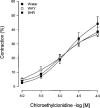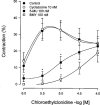Differential response to chloroethylclonidine in blood vessels of normotensive and spontaneously hypertensive rats: role of alpha 1D- and alpha 1A-adrenoceptors in contraction
- PMID: 10683189
- PMCID: PMC1571888
- DOI: 10.1038/sj.bjp.0703097
Differential response to chloroethylclonidine in blood vessels of normotensive and spontaneously hypertensive rats: role of alpha 1D- and alpha 1A-adrenoceptors in contraction
Abstract
The effects of chloroethylclonidine on alpha(1)-adrenoceptor-mediated contraction in endothelium-denuded caudal arteries and aorta from normotensive Wistar and Wistar Kyoto (WKY), and from spontaneously hypertensive (SHR) rats were evaluated. Chloroethylclonidine elicited concentration-dependent contractions. Maximal contraction was similar in caudal arteries among strains ( approximately 40% of noradrenaline effect). However, chloroethylclonidine elicited a higher contraction in aorta from SHR than from normotensive rats. In Wistar aorta chloroethylclonidine produced the smallest contractile response. In SHR aorta, BMY 7378 and 5-methylurapidil blocked chloroethylclonidine-elicited contraction, while (+)-cyclazocine did not inhibit it; while in caudal arteries, 5-methylurapidil blocked chloroethylclonidine action; the other antagonists had no effect. In chloroethylclonidine-treated aorta noradrenaline elicited biphasic contraction-response curves, indicating a high affinity (pD(2), 8.5 - 7.5) chloroethylclonidine-sensitive component and a low affinity (pD(2), 6.3 - 5.2) chloroethylclonidine-insensitive component. The high affinity component was blocked by chloroethylclonidine; while in caudal arteries noradrenaline elicited monophasic contraction-response curves with pD(2) values (6.5 - 5.7) similar to the low affinity component in aorta. Chloroethylclonidine inhibition of noradrenaline response was greater in aorta than in caudal arteries. Chloroethylclonidine increased the EC(50) values of noradrenaline approximately 1000 fold in aorta and approximately 10 fold in caudal arteries. In SHR aorta BMY 7378 protected alpha(1D)-adrenoceptors and in caudal arteries 5-methylurapidil protected alpha(1A)-adrenoceptors from chloroethylclonidine alkylation, allowing noradrenaline to elicit contraction. These results show marked strain-dependent differences in the ability of chloroethylclonidine to contract aorta; moreover, chloroethylclonidine stimulates alpha(1D)-adrenoceptors in aorta and alpha(1A)-adrenoceptors in caudal arteries. The higher contraction observed in aorta from SHR and WKY suggests an augmented number of alpha(1D)-adrenoceptors in these strains.
Figures








Similar articles
-
The influence of chloroethylclonidine-induced contraction in isolated arteries of Wistar Kyoto rats: alpha1D- and alpha1A-adrenoceptors, protein kinase C, and calcium influx.Arch Med Res. 2001 Jul-Aug;32(4):258-62. doi: 10.1016/s0188-4409(01)00286-7. Arch Med Res. 2001. PMID: 11440779
-
Chloroethylclonidine is a partial alpha1-adrenoceptor agonist in aorta and caudal arteries of the Wistar Kyoto rat.Eur J Pharmacol. 1998 Jun 12;351(1):49-52. doi: 10.1016/s0014-2999(98)00275-1. Eur J Pharmacol. 1998. PMID: 9698204
-
Evidence that alpha(1B)-adrenoceptors are involved in noradrenaline-induced contractions of rat tail artery.Eur J Pharmacol. 2004 Mar 19;488(1-3):157-67. doi: 10.1016/j.ejphar.2004.02.020. Eur J Pharmacol. 2004. PMID: 15044047
-
The alpha-adrenoceptor-mediated actions of chloroethylclonidine.Gen Pharmacol. 1997 Feb;28(2):197-201. doi: 10.1016/s0306-3623(96)00187-5. Gen Pharmacol. 1997. PMID: 9013194 Review.
-
[Modification of classical drug receptor mechanisms].Nihon Yakurigaku Zasshi. 1992 Oct;100(4):279-92. doi: 10.1254/fpj.100.279. Nihon Yakurigaku Zasshi. 1992. PMID: 1359993 Review. Japanese.
Cited by
-
The alpha(1D)-adrenergic receptor directly regulates arterial blood pressure via vasoconstriction.J Clin Invest. 2002 Mar;109(6):765-75. doi: 10.1172/JCI14001. J Clin Invest. 2002. PMID: 11901185 Free PMC article.
-
A systems biology approach to uncovering pharmacological synergy in herbal medicines with applications to cardiovascular disease.Evid Based Complement Alternat Med. 2012;2012:519031. doi: 10.1155/2012/519031. Epub 2012 Nov 29. Evid Based Complement Alternat Med. 2012. PMID: 23243453 Free PMC article.
-
Influence of combined hypertension and renal failure on functional alpha(1)-adrenoceptor subtypes in the rat kidney.Br J Pharmacol. 2008 Mar;153(6):1232-41. doi: 10.1038/bjp.2008.13. Epub 2008 Feb 11. Br J Pharmacol. 2008. PMID: 18246093 Free PMC article.
-
Inhibition of vascular smooth muscle G protein-coupled receptor kinase 2 enhances alpha1D-adrenergic receptor constriction.Am J Physiol Heart Circ Physiol. 2008 Oct;295(4):H1695-704. doi: 10.1152/ajpheart.00564.2008. Epub 2008 Aug 22. Am J Physiol Heart Circ Physiol. 2008. PMID: 18723764 Free PMC article.
-
Pathological role of a constitutively active population of alpha(1D)-adrenoceptors in arteries of spontaneously hypertensive rats.Br J Pharmacol. 2002 Jan;135(1):206-16. doi: 10.1038/sj.bjp.0704447. Br J Pharmacol. 2002. PMID: 11786496 Free PMC article.
References
-
- DOCHERTY J.R., O'ROURKE M. The α-adrenoceptor-mediated actions of chloroethylclonidine. Gen. Pharmac. 1997;28:197–201. - PubMed
-
- FURCHGOTT R.F., ZAWADZKI J.V. The obligatory role of endothelial cells in the relaxation of arterial smooth muscle by acetylcholine. Nature. 1980;288:373–376. - PubMed
-
- GIARDINA D., CRUCIANELLI M., ROMANELLI R., LEONARDI A., POGESSI E., MELCHIORRE C. Synthesis and biological profile of the enantiomers of [4-(4-amino-6, 7-dimethoxyquinazolin-2-yl) -cis- octahydroquinoxalin-1-yl] furan-2-ylmethanone (Cyclazocin), a potent competitive α1B-adrenoceptor antagonist. J. Med. Chem. 1996;39:4602–4607. - PubMed
-
- GOETZ A.S., KING H.K., WARD S.D.C., TRUE T.A., RIMELE T.J., SAUSSY D.L. BMY 7378 is a selective antagonist of the D subtype of α1-adrenoceptors. Eur. J. Pharmacol. 1995;272:R5–R6. - PubMed
Publication types
MeSH terms
Substances
LinkOut - more resources
Full Text Sources

